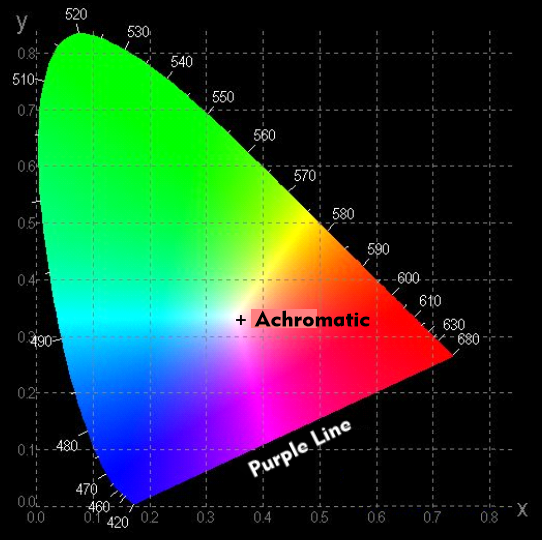commission internationale d`Eclairage (CIE)
The CIE color model, designed by the Commission Internationale d`Eclairage (CIE), the international lighting commission, was developed for the printing industry in 1931 (CIE 1931). This model corresponds to the visual perception of most people and is based on extensive tests and trials. The CIE color space, which comprises the color coordinates for monochromatic light with wavelengths between 380 nm and 700 nm, has also found its way into color management systems as a reference color space.
The CIE color space is a two-dimensional color space. The colors are located within the chromatic space curve that surrounds the color space. On this space curve, the wavelengths are plotted between blue at 380 nm, through green to red at 700 nm. The straight line that delimits the color space below between blue and red is the Line of Purples. Saturated colors are on the outer boundary, less saturated and unsaturated are between the outer boundary and the achromatic point, which is the white point. In the CIE color space, each color occurring in nature is determined by two XY coordinate values. The omission of negative values was achieved by linear transformation of a coordinate system with negative color values.
DIN divided the CIE color space into a total of 22 color areas in the DIN 5033 standard and assigned wavelengths to the individual color areas. In this diagram, the primary colors red (R), green (G) and blue (B) are identified with a single capital letter, as are yellow (Y), orange (O) and purple (P), the mixed colors blue-green (BG), yellow-green (YG) and red-purple ( RP) with two capital letters, and the colors in between, such as purple red (pR), blue purple (bP) or red orange (rO) with a letter combination of lower and upper case letters.
Exact definition of red, green and blue
In the CIE color space, the wavelengths for the three monochromatic primary colors red, green and blue are precisely defined. As mixed colors, these come closest to the human perception of color. According to this, red has a wavelength of 700 nm, green has 546.1 nm and blue (violet) 435.8 nm.
In addition to the color space defined by the CIE, this CIE commission has defined two color systems: CIELab and CIELuv. These color models are three-dimensional color models that have the shape of a sphere. In the Lab designation, fthe "L" stands for luminance, the "a" corresponds to the horizontal axis of the color model with the colors red-green, and the "b" corresponds to the vertical axis with the colors yellow-blue. The saturated spectral colors lie on a line corresponding to the circumference of the sphere at the center of the sphere (equator). The spherical axis corresponds to the brightness value and the respective radius to the color saturation. The three characteristic values color, brightness and saturation determine the color locus. The totality of the chromaticity coordinates is the color space. CIELuv works with a comparable model with the difference that it is used for light sources.

